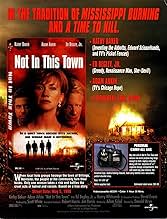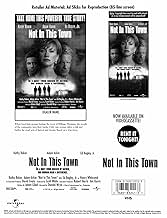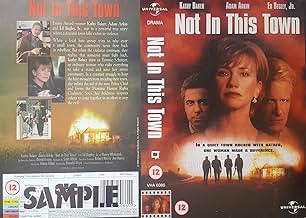Agrega una trama en tu idiomaWhen local hate groups besiege the town of Billings, Montana, the people of the community turn their backs. Only one woman takes a risk and battles the cruel acts of hatred and racism.When local hate groups besiege the town of Billings, Montana, the people of the community turn their backs. Only one woman takes a risk and battles the cruel acts of hatred and racism.When local hate groups besiege the town of Billings, Montana, the people of the community turn their backs. Only one woman takes a risk and battles the cruel acts of hatred and racism.
- Dirección
- Guionista
- Elenco
Max Gail
- Wayne Inman
- (as Max Gail Jr.)
- Dirección
- Guionista
- Todo el elenco y el equipo
- Producción, taquilla y más en IMDbPro
Opiniones destacadas
10BBB-7
Should be aired more frequently and in prime time.
People in all societies should be more aware of hate crimes and the reality that they can happen anywhere to anyone.
People in all societies should be more aware of hate crimes and the reality that they can happen anywhere to anyone.
I've just been watching this film on TV, and agree that it is syrupy. However, it does follow the actual story quite closely, on the whole. The syrup is in the script and the production values, not the plot.
I wasn't clear whether the writers of the comments from the Isle of Bute and London thought that racism isn't like this in America, or that racism is just fine by them.
In the real Billings, the attacks were perpetrated by skinheads, the Klan, and the Aryan Nation. Those targeted were indeed Native Americans, Jews, and African-American churchgoers. Painters did stop work to help. Thousands of people did put menorahs, or pictures of menorahs, in their windows.
For web pages about what actually happened in Billings, see
http://www.pbs.org/niot/about/niot1.html
I wasn't clear whether the writers of the comments from the Isle of Bute and London thought that racism isn't like this in America, or that racism is just fine by them.
In the real Billings, the attacks were perpetrated by skinheads, the Klan, and the Aryan Nation. Those targeted were indeed Native Americans, Jews, and African-American churchgoers. Painters did stop work to help. Thousands of people did put menorahs, or pictures of menorahs, in their windows.
For web pages about what actually happened in Billings, see
http://www.pbs.org/niot/about/niot1.html
Showed there was some risk of retribution if you are among the first to protest bigotry. That is, the first people to put up "no hate" signs were themselves made targets. Ed Begley's character was portrayed as very smooth. What he said seemed reasonable to appeal to people who were unemployed and who were not out and out bigots. The fact that it was based on a true story gave it credibility that a community can come together to fight a problem. Same thing could apply to combat street gangs or drug dealers in your neighborhood. The fact that the grandmother pulled back because her granddaughter had changed her religion is the same thing that happens when a child comes out as a homosexual in many cases.
And Adam Arkin again delivers a very good performance in this film about racism and bigotry.
Based on the true story of Tammy and Eliot Scnitzer, we have seen the story before, but it is well-presented here. The scene in the church is a bit heavy-handed, as the people are singing "Lay my burdens down Lord", and the racist group backs down. Actually they were probably such cowards that they did all their vandalism late at night, anyway.
More recent films, such as "American History X" (Ed Norton) are extremely disturbing, and (for me anyway) a bit too violent to watch. Yes, we do need to know these issues exist. At least this movie does not have gratuitous violence and rape, and yes it should be shown more often on prime time TV.
The Ed Begley character (as Henry Whitcomb) is a white supremacist who seemingly recruits groups in the Billings, Montana area. At the end he tells the ineffectual racist cowards they have failed. People are now putting menorahs in the window, the newspaper has helped the community; people are now willing to fight back, which defeats the group. Ed Begley has a thankless role here (His father also portrayed the bigot in "12 Angry Men"). All in all this is a good film which deals with an important subject. 9/10.
Based on the true story of Tammy and Eliot Scnitzer, we have seen the story before, but it is well-presented here. The scene in the church is a bit heavy-handed, as the people are singing "Lay my burdens down Lord", and the racist group backs down. Actually they were probably such cowards that they did all their vandalism late at night, anyway.
More recent films, such as "American History X" (Ed Norton) are extremely disturbing, and (for me anyway) a bit too violent to watch. Yes, we do need to know these issues exist. At least this movie does not have gratuitous violence and rape, and yes it should be shown more often on prime time TV.
The Ed Begley character (as Henry Whitcomb) is a white supremacist who seemingly recruits groups in the Billings, Montana area. At the end he tells the ineffectual racist cowards they have failed. People are now putting menorahs in the window, the newspaper has helped the community; people are now willing to fight back, which defeats the group. Ed Begley has a thankless role here (His father also portrayed the bigot in "12 Angry Men"). All in all this is a good film which deals with an important subject. 9/10.
First of all, in response to another message posted, Billings, Montana is NOT a town full of rednecks. I grew up in that town, and I was in high school there in 1993.
I thought the movie was okay. It does have an important message about how people standing together can help defeat bigotry. It shows how "silence implies consent," and that people doing nothing only encourages bigotry. When so many people stood together against bigotry, the incidents stopped, slowly but surely.
The movie does embellish a lot of details, and it leaves many details out. For instance, there is no mention in the movie about the bias incidents happening in the high schools around town about the same time. When the kids saw the adults standing up against the bigotry, many of them started doing that as well, and the number of incidents decreased.
The slogan was actually "NOT IN OUR TOWN" and it was posted on the billboard of a sporting goods store. One would think that the people making the movie would get at least that right.
Some things that happened were very much dramatized, and some things that didn't happen were added. I was a bit confused by the movie the first time I watched it, as so much was changed.
Overall, the movie does have an important message. However, take some time to learn the real story behind the movie.
I thought the movie was okay. It does have an important message about how people standing together can help defeat bigotry. It shows how "silence implies consent," and that people doing nothing only encourages bigotry. When so many people stood together against bigotry, the incidents stopped, slowly but surely.
The movie does embellish a lot of details, and it leaves many details out. For instance, there is no mention in the movie about the bias incidents happening in the high schools around town about the same time. When the kids saw the adults standing up against the bigotry, many of them started doing that as well, and the number of incidents decreased.
The slogan was actually "NOT IN OUR TOWN" and it was posted on the billboard of a sporting goods store. One would think that the people making the movie would get at least that right.
Some things that happened were very much dramatized, and some things that didn't happen were added. I was a bit confused by the movie the first time I watched it, as so much was changed.
Overall, the movie does have an important message. However, take some time to learn the real story behind the movie.
¿Sabías que…?
- TriviaLeads Kathy Baker, Adam Arkin, and Ed Begley Jr. are all best-known for playing TV doctors on the shows "Picket Fences", "Chicago Hope" and "St. Elsewhere", respectively. Both "Picket Fences" and "Chicago Hope" were created by David E. Kelley.
Selecciones populares
Inicia sesión para calificar y agrega a la lista de videos para obtener recomendaciones personalizadas
Detalles
Contribuir a esta página
Sugiere una edición o agrega el contenido que falta












